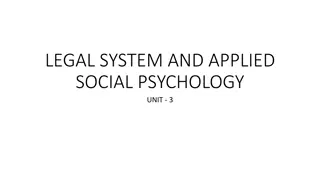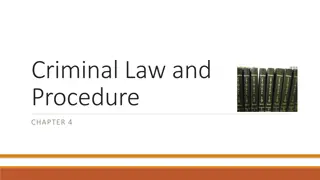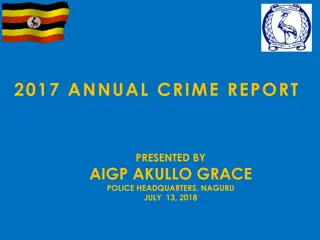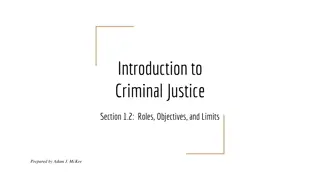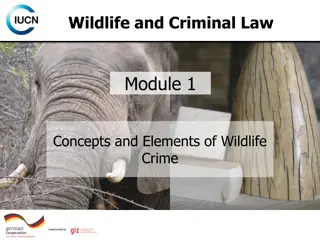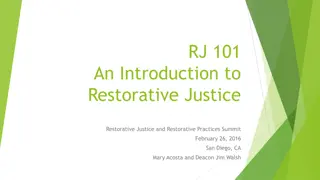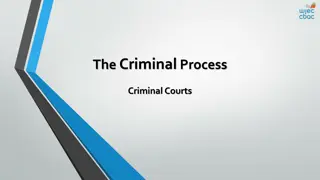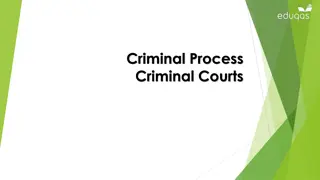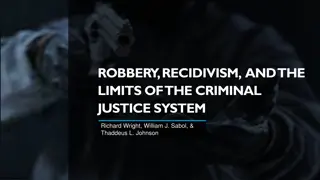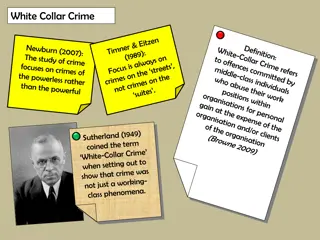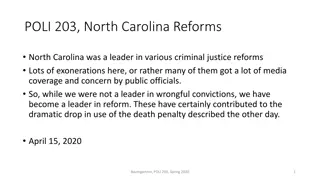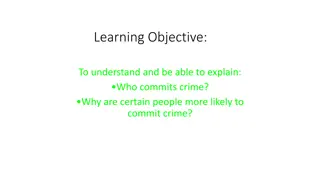Understanding Crime in the Criminal Justice System
This content delves into defining and measuring crime within the criminal justice system, discussing the types of crimes such as misdemeanors and felonies, alongside common law felonies and misdemeanors. It also highlights dual classifications of crimes and provides insight into the various offenses that can be categorized as misdemeanors or felonies based on the circumstances.
Download Presentation

Please find below an Image/Link to download the presentation.
The content on the website is provided AS IS for your information and personal use only. It may not be sold, licensed, or shared on other websites without obtaining consent from the author. Download presentation by click this link. If you encounter any issues during the download, it is possible that the publisher has removed the file from their server.
E N D
Presentation Transcript
Introduction to Criminal Justice Section 1.3: Defining and Measuring Crime Prepared by Adam J. McKee
Defining Crime A crime is an act or omission that is prohibited by law. For a law to be valid, a particular punishment or range of punishments must be specified. In the United States, the most common punishments are fines and imprisonment. As a matter of legal theory, a crime is a failed duty to the community for which the community will exact some punishment. 2
Types of Crimes Historically, legal scholars differentiated between things that were "wrongs in themselves," which were referred to as mala in se offenses. These were distinct from mala prohibita offenses, which represented acts that were criminal merely because the government wished to prohibit them. Many criminal justice scholars use these terms to differentiate between heinous crimes like rape and murder and victimless crimes such as gambling and vagrancy. 3
Misdemeanors Today, the most common and most basic division of crimes is based on the seriousness of the offense, and thus the possible punishment. Misdemeanors are less serious crimes that are punishable by fine and confinement in a local jail for a period not to exceed a year. 4
Felonies Felonies are more serious crimes that the government punishes by fines, imprisonment (most commonly under the auspices of the state s Department of Corrections) for a period exceeding a year, or death. The distinction between misdemeanors and felonies is of ancient origin, coming to us through the Common Law of England. 5
Common Law Felonies Common law felonies included: 1. murder 2. rapemayhem 3. robbery 4. sodomy 5. larceny 6. arson 7. manslaughter 8. burglary 6
Common Misdemeanors What is classified as a misdemeanor largely depends on the jurisdiction. Common examples are: petty theft prostitution public intoxication simple assault disorderly conduct vandalism 7
Dual Classifications Some crimes can be both misdemeanors and felonies, depending on the circumstances. A battery that results in a handprint on the victim s face may be classified as a misdemeanor, while a kick that breaks the victim s ribs may be a felony. Similarly, an arson that does relatively little damage (in terms of financial costs) may be a misdemeanor, while an arson that destroys a home will be a felony. 8
Labeling Offenders These distinctions have made it into our popular culture, where criminals who commit felonies are often known as felons. Less commonly used is the term misdemeanant, who is a person convicted of misdemeanor. 9
Violations Most jurisdictions recognize a class of offenses that do not result in any period of incarceration, and are punished with only a fine. These minor breaches of the law are usually called violations. 10
Crime Statistics To understand crime and the criminal justice system, we need to understand the prevalence of crime. Good crime statistics are critically important to understanding crime trends. The more federal and state agencies know about crime trends, the more intelligently they can allocate precious resources and maximize efforts at crime suppression and prevention. Crime statistics are also frequently used as an evaluation tool for justice programs. 11
Crime Rates If the rate of a particular crime is falling, then what the system is doing will seem to be working. If the rate of a particular crime is rising, then it will seem to indicate that the criminal justice system is failing. 12
Uniform Crime Reports In the United States, the most frequently cited crime statistics come from the FBI s Uniform Crime Reports (UCR). The UCR are crime data collected by over 16,000 local and state law enforcement agencies on crimes that have been brought to the attention of police. These law enforcement agencies voluntarily send information to the FBI, which compiles them into an annual published report along with several special reports on particular issues. 13
Criticisms of the UCR Since its inception in the 1930s, many people have been critical of the UCR system for a variety of reasons. Among these reasons are: only crimes reported to the police are included only counts the most serious crime committed in a series of crimes does not differentiate between completed crimes and attempts does not include many types of crimes(e.g., white-collar and federal crimes). 14
Social Scientists Complaints Scholars complained that the UCR did not obtain potentially important information about the victim, the offender, the location of the crime and so forth. Without this information, social scientists could not use the UCR data in attempts to explain and predict crime. These complaints eventually led to the development of a much more informative system of crime reporting known as the National Incident Based Reporting System (NIBRS). 15
Defining NIBRS The NIBRS is an incident-based reporting system in which agencies collect data on each single crime occurrence. NIBRS data come from local, state, and federal automated records systems. 16
What NIBRS Includes The NIBRS collects data on each single incident and arrest within 22 offense categories made up of 46 specific crimes called Group A offenses. For each of the offenses coming to the attention of law enforcement, specified types of facts about each crime are reported. In addition to the Group A offenses, there are 11 Group B offense categories for which only arrest data are reported. 17
Benefits of NIBRS Can furnish information on nearly every major criminal justice issue facing law enforcement today. Legislators and other stakeholders have access to more comprehensive crime information than the summary reporting can provide. fight crime. Enables agencies to find similarities in crime-fighting problems so that agencies can work together to develop solutions. Provides statistics to enable a law enforcement agency to provide a full accounting of the status of public safety within the jurisdiction. Law enforcement can better make a case to acquire the resources needed to 18
Problems with NIBRS The major problem with NIBRS today is that it has not been universally implemented. Agencies and state Programs are still in the process of developing, testing, or implementing the NIBRS. In 2004, 5,271 law enforcement agencies contributed NIBRS data to the UCR Program. The data from those agencies represent 20 percent of the U.S. population and 16 percent of the crime statistics collected by the UCR Program. 19
The Dark Figure of Crime A commonly cited problem with the UCR is that there are many, many crimes that do not come to the attention of police. This problem is not limited to minor offenses. For example, it is estimated that nearly half of all rapes go unreported. These undocumented offenses are often referred to as the dark figure of crime. 20
National Crime Victimization Survey (NCVS) This is the reason that the United States is the Bureau of Justice Statistics' (BJS) developed the National Crime Victimization Survey (NCVS). The NCVS, which began in 1973, provides a detailed picture of crime incidents, victims, and trends. 21
What the NCVS Measures Today, the survey collects detailed information on the frequency and nature of the crimes of: rape and sexual assault personal robbery aggravated and simple assault household burglary theft motor vehicle theft. It does not measure homicide or commercial crimes. 22
The NCVS Data Two times a year, U.S. Census Bureau personnel interview household members in a nationally representative sample of approximately 42,000 households (about 75,000 people). Approximately 150,000 interviews of persons age 12 or older are conducted annually. Households stay in the sample for three years. New households are rotated into the sample on an ongoing basis. 23





